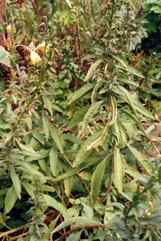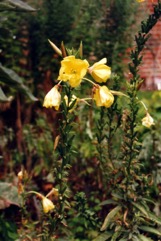Evening primrose

It is a temperate plant. It will grow in dry poor soils. In China it grows in open disturbed places from sea level to 1,500 m above sea level. In Argentina it grows from sea level to 1,000 m above sea level. In Hobart Botanical gardens. It suits hardiness zones 4-9. Tasmania Herbarium. In Sichuan and Yunnan.
Also known as:
Bunga sore, Don-la-ban, Dvoletni svetlin, Evening Star, Gardener's ham, German rampion, Luminnita noptii, Primros kuning, Sun drop
Synonyms
- Brunyera biennis Bubani
- Oenothera muricata L.
- Oenothera suaveolens Desf.
- Onagra biennis (L.) Scop.
- Onagra muricata (L.) Moench.
Edible Portion
- Roots, Leaves, Seeds - oil, Herb, Flowers, Vegetable
Where does Evening primrose grow?
Found in: Africa, Argentina, Asia, Australia, Bhutan, Brazil, Britain, Canada, Central Asia, Chile, China, Czech Republic, Eswatini, Europe, France, Germany, Himalayas, Indonesia, Ireland, Japan, Kazakhstan, Korea, Kyrgyzstan, Luxembourg, Moldova, Myanmar, New Zealand, North America, Pacific, Russia, SE Asia, Slovenia, South Africa, Southern Africa, South America, Swaziland, Taiwan, Tasmania, United States
Notes: There are about 125 Oenothera species. The oil from the seeds are used for Menstral problems. It also has an anti-inflammatory compound.
Status: It is a commercially cultivated vegetable.
Growing Evening primrose
Cultivation: Plants can be grown from seeds.
Edible Uses: The leaves can be used raw in salads. They are also used as a potherb. They can be cooked as a vegetable. The young roots are eaten raw or cooked. They are boiled in 2 changes of water to remove bitterness then added to soups and stews. The sweet flowers can be used in salads or garnish in pickles. The seeds yield an oil that can be used for salads or as a food supplement. Young pods are steamed and eaten.
Production: The highest linolenic acid levels are achieved on poor soils with a low nitrogen level.
Nutrition Info
per 100g edible portion| Edible Part | Energy (kcal) | Protein (g) | Iron (mg) | Vitamin A (ug) | Vitamin c (mg) | Zinc (mg) | % Water |
|---|---|---|---|---|---|---|---|
| - | - | - | - | - | - |
Evening primrose Photos


References
Bodkin, F., 1991, Encyclopedia Botanica. Cornstalk publishing, p 735
Bremness, L., 1994, Herbs. Collins Eyewitness Handbooks. Harper Collins. p 259
Brickell, C. (Ed.), 1999, The Royal Horticultural Society A-Z Encyclopedia of Garden Plants. Convent Garden Books. p 717
Burnie, G & Fenton-Smith, J., 1999, A Grower's Guide to Herbs. Murdoch Books. p 32
Cerne, M., 1992, Wild Plants from Slovenia used as Vegetables. Acta Horticulturae 318
Ciocarlan, N. & Ghendov, V., 2015, Ethnobotanical and Ecological Studies of Wild Edible Plants from Bugeac Steppe, Republic of Moldova. Journal of EcoAgriTourism. Cailta terra Vol. 11(2):
Cormack, R. G. H., 1967, Wild Flowers of Alberta. Commercial Printers Edmonton, Canada. p 218
Cundall, P., (ed.), 2004, Gardening Australia: flora: the gardener's bible. ABC Books. p 947
Duke, J.A., 1992, Handbook of Edible Weeds. CRC Press. p 138
Elias, T.S. & Dykeman P.A., 1990, Edible Wild Plants. A North American Field guide. Sterling, New York p 103
Esperanca, M. J., 1988. Surviving in the wild. A glance at the wild plants and their uses. Vol. 1. p 341
Facciola, S., 1998, Cornucopia 2: a Source Book of Edible Plants. Kampong Publications, p 164
Heywood, V.H., Brummitt, R.K., Culham, A., and Seberg, O. 2007, Flowering Plant Families of the World. Royal Botanical Gardens, Kew. p 237
Hedrick, U.P., 1919, (Ed.), Sturtevant's edible plants of the world. p 446
Hibbert, M., 2002, The Aussie Plant Finder 2002, Florilegium. p 213
http://www.botanic-gardens-ljubljana.com/en/plants
Irving, M., 2009, The Forager Handbook, A Guide to the Edible Plants of Britain. Ebury Press p 306
Joyce, D., 1998, The Garden Plant Selector. Ryland, Peters and Small. p 250
Kays, S. J., and Dias, J. C. S., 1995, Common Names of Commercially Cultivated Vegetables of the World in 15 languages. Economic Botany, Vol. 49, No. 2, pp. 115-152
Kiple, K.F. & Ornelas, K.C., (eds), 2000, The Cambridge World History of Food. CUP p 1772
Lim, T. K., 2015, Edible Medicinal and Non Medicinal Plants. Volume 9, Modified Stems, Roots, Bulbs. Springer p 60
Long, C., 2005, Swaziland's Flora - siSwati names and Uses http://www.sntc.org.sz/flora/
MacKinnon, A., et al, 2009, Edible & Medicinal Plants of Canada. Lone Pine. p 233
Moerman, D. F., 2010, Native American Ethnobotany. Timber Press. p 361
Plants for a Future database, The Field, Penpol, Lostwithiel, Cornwall, PL22 0NG, UK. http://www.scs.leeds.ac.uk/pfaf/
Simkova, K. et al, 2014, Ethnobotanical review of wild edible plants used in the Czech Republic. Journal of Applied Botany and Food Quality 88, 49-67
Sp. pl. 1:346. 1753
Stern, G., 1986, Australian Weeds. A Source of Food and Medicine. Harper & Row. p 75
Sukarya, D. G., (Ed.) 2013, 3,500 Plant Species of the Botanic Gardens of Indonesia. LIPI p 1127
Swaziland's Flora Database http://www.sntc.org.sz/flora
Tasmanian Herbarium Vascular Plants list p 42
www.ediblewildfood.com